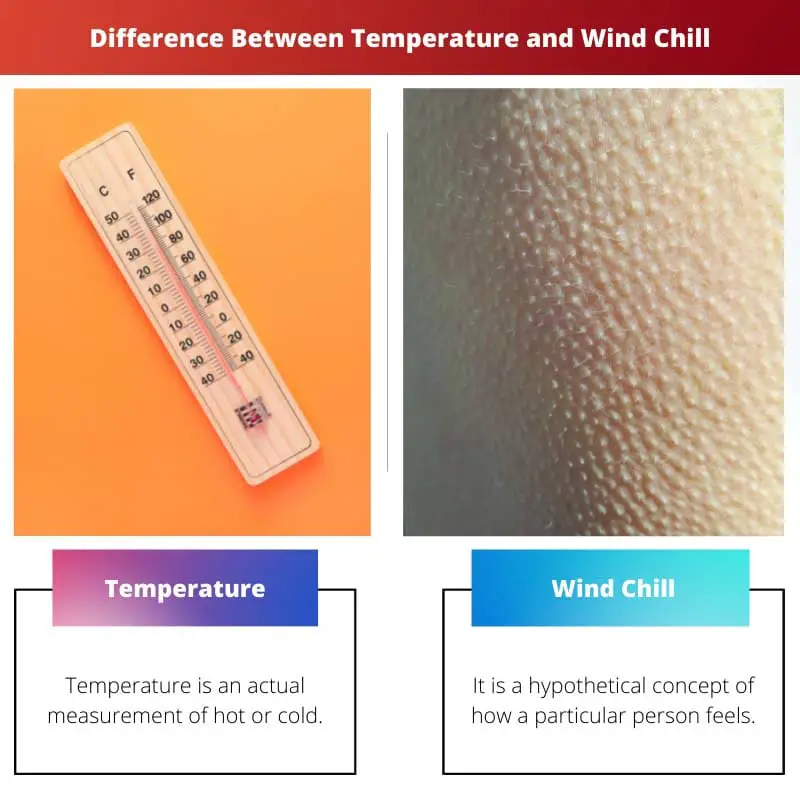Certain ideas are utilized in the fields of meteorology and thermodynamics. The themes of wind chill and temperature are two of these notions.
Temperature is an actual scientific confect that is calculated based on various factors and on the other hand, wind chill is based solely on the human feeling the temperature at that very moment.
Key Takeaways
- Temperature measures the degree of heat in the air, while wind chill reflects how cold the air feels on exposed skin.
- Wind chill combines temperature and wind speed to estimate the cooling effect of wind on the body.
- The wind chill is important for understanding the risk of frostbite and hypothermia during cold weather conditions.
Temperature vs Wind Chill
Temperature is a measure of the average kinetic energy of the air molecules, and it’s reported in degrees Celsius/Fahrenheit. It’s a measure of the exact temperature of the air and is not affected by wind speed. The wind chill is a measure of how cold it feels outside when wind speed is considered.

The common conceptions of hot and cold have developed into the concept of temperature. The sense of what is hot or cold is subjective.
The operational definition of temperature is what we can measure using a thermometer.
A polynomial or power function can be used to calculate the connection between temperature and the thermometric variable, which can be direct or inverse.
The feeling of being chilled by the wind is quite similar to how we feel as people. It’s a measurement of how quickly our bodies lose heat.
Because wind takes heat away from our skin quicker than it would if there was no wind, it will speed up our body’s heat loss.
As a result, wind chill is the temperature at which we would lose heat at the same rate as if no wind existed.
Comparison Table
| Parameters of Comparison | Temperature | Wind Chill |
|---|---|---|
| Definition | Temperature is an actual measurement of hot or cold. | It is a hypothetical concept of how a particular person feels. |
| Calculation | Calculated using formula. | It is not calculated. |
| Concept | It is a measure of the kinetic energy of moving molecules. | It changes with the speed of the wind. |
| Measure | It tells the actual temperature. | It is lower in temperature than the actual one. |
| Units | It is expressed in three different units like kelvin, Celcius, and Fahrenheit. | Does not have any SI units. |
What is Temperature?
Temperature is a measure of hotness or coldness stated on any of numerous arbitrary scales that indicate the direction in which heat energy would naturally flow—that is, from a hotter body to a colder body.
Temperature is not the same as the energy in a thermodynamic system, for example, a burning match has a significantly higher temperature compared to an iceberg, but the cumulative heat energy in an iceberg is far more than the energy in a match.
Temperature is an intense property, like pressure or density, in that it is independent of the quantity of stuff being addressed, as opposed to widespread characteristics like mass or volume.
Today, three temperature scales are widely used. In the United States and a few other English-speaking nations, the Fahrenheit (°F) temperature scale is used.
The Celsius (°C) temperature scale is widely used in science and is used in practically all nations that have adopted the metric system of measurement.
The Kelvin (K) scale is the international standard for scientific temperature measurement. It is an absolute temperature scale.
Water has a freezing point of 0 °C and a boiling temperature of 100 °C on the Celsius scale. The degree Celsius (°C) is the unit of measurement.
Water has a freezing point of 32 degrees Fahrenheit and a boiling temperature of 212 degrees Fahrenheit on the Fahrenheit scale.

What is Wind Chill?
When exposed to outdoors windy circumstances, wind chill refers to one’s perceived visible temperature on the skin.
It is more about the individual’s perception of temperature than the actual temperature, which is a separate idea.
The felt temperature of wind chills fluctuates based on two factors: first, how rapidly the wind moves, and second, how cold or hot the air is.
The rate of heat loss from skin exposed to the air is measured by wind chill, sometimes spelt windchill and dubbed wind chill factor.
It’s predicated on the fact that when wind speeds rise, so does heat loss, making the air “feel” colder.
The wind chill is commonly expressed as a “wind chill temperature” or “wind chill equivalent”, that is, the temperature at which heat loss would be equal to that experienced due to greater wind speeds in calm air.
A wind chill temperature of 25 °C or can, say, 13 °F in calm air, for example, would be equivalent to the real air temperature. Exposed flesh would freeze in 30 minutes at these settings.
The wind chill temperature would be 41 °C or can, say, 42 °F at a speed of 40 km/h (25 miles/h), and the skin would freeze in less than 10 minutes.
The formulae and assumptions used to compute wind chill temperatures, known as wind chill indices, have changed over time.
The Siple-Passel index, based on windspeeds recorded by an anemometer 10 meters (33 feet) above the ground, was widely employed in North American weather predictions in the second half of the twentieth century.
Main Differences Between Temperature and Wind Chill
- Temperature is the actual measurement of hot and cold, whereas wind chill is a concept of how a particular person felt the temperature when exposed to the weather.
- The temperature of any material or the weather depends on several factors and, thus, is calculated using a formula, whereas the wind chill is a measure of one’s perception, and it changes for every individual.
- Temperature is a broader concept of the kinetic energy of the moving particles of a body or the wind, while wind chill is solely a person’s concept that changes with the speed of the wind that they feel.
- Temperature is an actual measurement, whereas the wind chill perceived is lower than the actual temperature.
- Temperature is expressed in the three SI units: kelvin, Celsius, and Fahrenheit, and wind chill does not have an SI unit.




